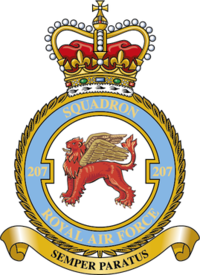
Royal Air Force Waddington otherwise known as RAF Waddington is a Royal Air Force station located beside the village of Waddington, 4.2 miles (6.8 km) south of Lincoln, Lincolnshire, in England.

Royal Air Force Marham, commonly abbreviated RAF Marham is a Royal Air Force station and military airbase near the village of Marham in the English county of Norfolk, East Anglia.

Number 617 Squadron is a Royal Air Force aircraft squadron, originally based at RAF Scampton in Lincolnshire and currently based at RAF Marham in Norfolk. It is commonly known as "The Dambusters", for its actions during Operation Chastise against German dams during the Second World War. In the early 21st century it operated the Panavia Tornado GR4 in the ground attack and reconnaissance role until being disbanded on 28 March 2014. The Dambusters reformed on 18 April 2018, and was equipped at RAF Marham in June 2018 with the Lockheed Martin F-35B Lightning, becoming the first squadron to be based in the UK with this advanced V/STOL type. The unit is composed of both RAF and Royal Navy personnel, and operates from the Royal Navy's Queen Elizabeth-class aircraft carriers.

Number 5 Squadron was a squadron of the Royal Air Force. It most recently operated the Raytheon Sentinel R1 Airborne STand-Off Radar (ASTOR) aircraft from RAF Waddington, Lincolnshire, between April 2004 until March 2021.
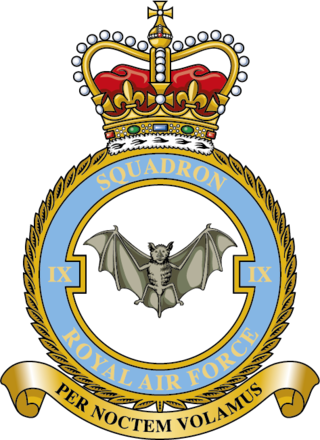
Number 9 Squadron is the oldest dedicated Bomber Squadron of the Royal Air Force. Formed in December 1914, it saw service throughout the First World War, including at the Somme and Passchendaele. During the Second World War, No. IX (B) Squadron was one of two Avro Lancaster units specialising in heavy precision bombing and sank the battleship Tirpitz on 12 November 1944 in Operation Catechism. Between 1962 and April 1982, the squadron flew the Avro Vulcan B.2 as part of the V-Force. In June 1982, it became the first front-line squadron in the world to operate the Panavia Tornado GR.1. In May 1998, No. IX (B) Squadron received the RAF's first Tornado GR.4, which it operated until reequipping with the Eurofighter Typhoon FGR.4 at its present home base of RAF Lossiemouth on 1 April 2019.
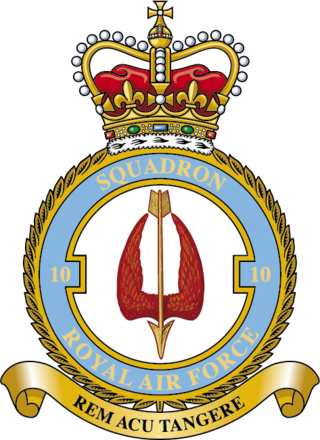
Number 10 Squadron is a Royal Air Force squadron. The squadron has served in a variety of roles over its 90-year history. It currently flies the Airbus Voyager KC2/KC3 in the transport/tanker role from RAF Brize Norton, Oxfordshire.
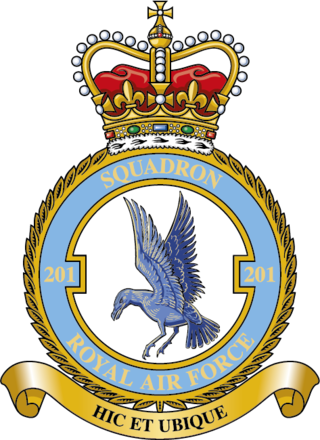
Number 201 Squadron is a squadron of the Royal Air Force. It currently operates the Boeing Poseidon MRA1 from RAF Lossiemouth, Moray.

Number 15 Squadron, sometimes written as No. XV Squadron, was a squadron of the Royal Air Force. It most recently operated the Panavia Tornado GR4 from RAF Lossiemouth as No. XV (Reserve) Squadron. It was the RAF's Operational Conversion Unit for the Tornado GR4 which taught pilots and Weapon Systems Officers (WSO) how to fly the aircraft and what tactics to use to best exploit the performance of their aircraft and its weapons.
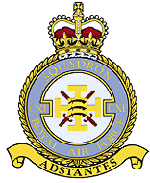
Number 111 (Fighter) Squadron, also known as No. CXI (F) Squadron and nicknamed Treble One, was a squadron of the Royal Air Force. It was formed in 1917 in the Middle East as No. 111 Squadron of the Royal Flying Corps during the reorganisation of the Egyptian Expeditionary Force after General Edmund Allenby took command during the Sinai and Palestine Campaign. The squadron remained in the Middle East after the end of the First World War until 1920 when it was renumbered as No. 14 Squadron.
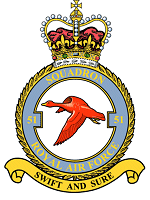
Number 51 Squadron is a squadron of the Royal Air Force. Since 2014 it has operated the Boeing RC-135W Airseeker R.1, more commonly referred to as the Rivet Joint, from RAF Waddington, Lincolnshire.

No. 1 Group of the Royal Air Force is one of the two operations groups in RAF Air Command. Today, the group is referred to as the Air Combat Group, as it controls the RAF's combat fast-jet aircraft and has airfields in the UK, as well as RAF Support Unit Goose Bay at CFB Goose Bay in Canada. The group headquarters is located alongside Headquarters Air Command at RAF High Wycombe, Buckinghamshire. The other operational group is No. 2 Group RAF.
No. 75 Squadron was a unit of the Royal Flying Corps and Royal Air Force in World War I and the RAF in World War II. In 1940–1945, it was a bomber unit comprised mainly of New Zealand-born personnel. In October 1945, the squadron number – along with its heraldry and honours – was relinquished by the RAF and transferred to the Royal New Zealand Air Force, officially becoming No. 75 Squadron RNZAF. No other RAF squadron has been gifted in this way, to another Commonwealth air force.
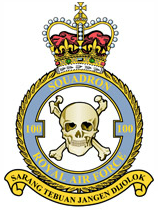
Number 100 Squadron is a former Royal Air Force squadron. It last operated the British Aerospace Hawk T1, providing 'aggressor' aircraft for air combat training from RAF Leeming in North Yorkshire, UK.
Royal Air Force Bircham Newton or more simply RAF Bircham Newton is a former Royal Air Force station located 2.1 miles (3.4 km) south east of Docking, Norfolk and 13.4 miles (21.6 km) north east of King's Lynn, Norfolk, England.

No. 35 Squadron was a squadron of the Royal Air Force.

The Fairey Hendon was a British monoplane, heavy bomber of the Royal Air Force, designed by Fairey Aviation in the late 1920s. The aircraft served in small numbers with one squadron of the RAF between 1936 and 1939. It was the first all-metal construction low-wing monoplane to enter service with the RAF.
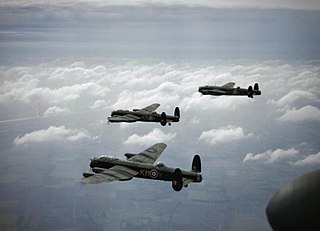
Number 44 (Rhodesia) Squadron was an aviation unit of the Royal Air Force. It was active between 1917 and 1982. For most of its history it served as a heavy bomber squadron.

809 Naval Air Squadron, nicknamed the Immortals, is a squadron of the Fleet Air Arm of the United Kingdom. It was first formed in 1941 and flew in the Soviet Union, the Mediterranean and the Far East during the Second World War. After active service during the Suez Crisis, 809 was disbanded in 1959. Reformed in 1963 to fly Blackburn Buccaneers, the squadron was disbanded briefly in 1965–66, and then again in 1978. A brief period during the Falklands War saw 809 reformed to bring Sea Harrier FRS.1 aircraft south to the UK task group and to fly from HMS Illustrious.
Number 76 Squadron was a squadron of the Royal Air Force. It was formed during World War I as a home defence fighter squadron and in its second incarnation during World War II flew as a bomber squadron, first as an operational training unit and later as an active bomber squadron. With the end of the war the squadron converted to the role of transport squadron, to be reactivated shortly in the bomber role during the 1950s. From 2007 to 2011, it was a training unit, equipped with the Short Tucano at RAF Linton-on-Ouse.
